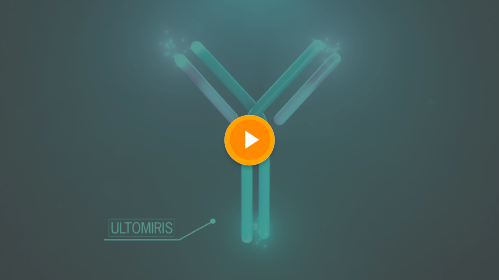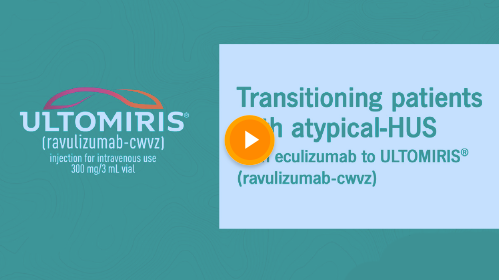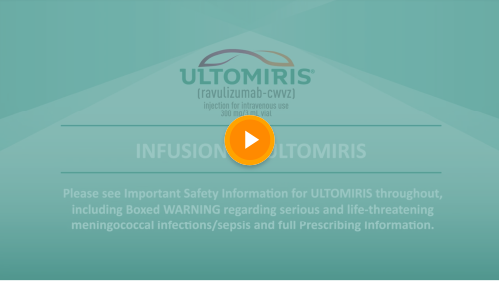Host:
ULTOMIRIS is the first and only long-acting medication for the treatment of atypical
hemolytic uremic syndrome, or atypical-HUS, in adult and pediatric patients one
month of age and older.1
As we talk about transitioning, it’s important to keep in mind how ULTOMIRIS
differs from eculizumab.
Like eculizumab, ULTOMIRIS binds to C5 in the bloodstream, although ULTOMIRIS binds
to FcRn with greater affinity.1-3
For eculizumab, binding to C5 inhibits FcRn-mediated recycling, which means that
eculizumab is destroyed when C5 is destroyed.3
ULTOMIRIS uses FcRn to recycle back to the bloodstream, leaving C5 to be degraded by
lysosomes.3
Through these modifications, ULTOMIRIS has a half-life of 51.8 days, approximately 4x
that of eculizumab, so ULTOMIRIS provides immediate, complete, and sustained
inhibition of C5 for up to 8 weeks, compared to 2 weeks with
eculizumab.1-3
This increased time between infusions can provide patients with additional freedom to
enjoy the things they love.1-3
Host:
We are fortunate to be joined today by Dr Edward George.
Co-founder and former leader of Virginia Oncology Associates, Dr George is a
board-certified hematology specialist who has treated or been consulted on many
patients diagnosed with atypical-HUS.
Dr George is a paid consultant for Alexion and has been compensated for his time.
Host:
Welcome, Dr George.
Let’s discuss a patient who received a diagnosis and care from a colleague in
your
practice.
This case certainly illustrates challenges faced by patients with atypical-HUS and
their transition from eculizumab to ULTOMIRIS.
This case is based on an actual patient, but the name has been changed to protect the
patient’s privacy.
Dr George, tell us about this patient’s history.
Dr George:
Well, thanks for letting me share this illustrative case.
Andrew’s history included significant issues, beginning early in his adult
life.
He was diagnosed with acute end-stage renal disease at age 25, he also suffered a
stroke, which caused permanent left visual field cut.
He went on dialysis until he was able to receive a kidney.
Unfortunately, the transplant had to be removed due to immunologic acute humoral
rejection, and so Andrew went back on dialysis.
In the process of dialysis, he had 3 arteriovenous fistulas, or AVFs, all of which
thrombosed.
At age 34, he received his second kidney transplant but experienced graft-related
pain, renal graft failure, and edema.
The pathology of the graft indicated a thrombotic microangiopathy, or a TMA.
Following that, he was misdiagnosed with thrombotic thrombocytopenic purpura, or TTP,
underwent plasmapheresis and, subsequently, had the second kidney transplant removed
because it failed.
Host:
Wow, what an experience this patient had. This really emphasizes the severity of this
condition. What happened next?
Dr George:
Andrew is an articulate and persistent advocate for his own health.
After being in contact with other patients in the transplant community, he came to
us, asking for a new opinion.
Our diagnosis went through the process of elimination.
His blood tests showed ADAMTS13 activity of 100%, which essentially ruled out a
TTP.4-6
He also received a negative stool test for Shiga toxin–producing E
coli, or
STEC.6
These, combined with a reassessment of his lab values and the exclusion of other
causes of TMA, indicated the patient had atypical-HUS, and Andrew was started on
eculizumab.6 He was immunized with meningococcal vaccines two weeks prior
to the administration of his first dose.1
The decision considered the failure of both of his transplants, even with
immunosuppression. And considering his 3 AVFs and his stroke, we sought complement
inhibition before considering a third transplant.
He subsequently underwent a third renal transplant and has been able to maintain it
to the present.
Host:
It would be understandable that many patients and physicians would consider this a
noteworthy resolution.
How did the idea of conversion to ULTOMIRIS emerge?
Dr George:
After almost 7 years of being treated with eculizumab, Andrew came to see us for a
follow-up visit, and this was about the same time that our practice became aware of
the impending approval of ULTOMIRIS.
With ULTOMIRIS for adult patients, infusions are administered once every 8 weeks vs
every 2 weeks with eculizumab.1,2
That’s a difference of 6 to 7 times per year vs 26 times per year.
Andrew was briefed on ULTOMIRIS by my colleague, who viewed the possibility of 8
weeks between infusions as an effective alternative to eculizumab.
Then, it all started to come together when ULTOMIRIS was approved.
When Andrew heard of its approval, he requested a thorough discussion of the data,
efficacy, safety, and risks.
Host:
Often, a caregiver or loved one is also involved in such a significant decision. Was
that the case here?
Dr George:
Yes.
Andrew had a lengthy discussion with his wife, and jointly they concluded that
transitioning to this new medication, with its proven efficacy data and
well-understood safety and tolerability profile, would be a good choice.1
He also believed that ULTOMIRIS would open up his schedule and create a more
convenient, less obligated lifestyle. In his words, it offered him additional
freedoms in his life.1
Host:
So, Andrew was then transitioned to ULTOMIRIS.2 Tell us more about that.
Dr George:
His transition to ULTOMIRIS went smoothly, other than early transient headache with
the first infusion and tiredness on the day of administration.
His impression of ULTOMIRIS remains positive. And it allows him to get back to doing
the things he loves.
Host:
As you reflect on this patient and the transition, what are the lessons learned?
Dr George:
ULTOMIRIS is FDA approved and has an established safety and efficacy
profile.1
In our practice, we have successfully transitioned many patients to ULTOMIRIS.
We feel all atypical-HUS patients on eculizumab should be considered for a transition
to ULTOMIRIS.
Don’t be surprised when patients say that the ULTOMIRIS 8-week infusion
interval for
adult atypical-HUS patients, vs 2 weeks with eculizumab, gives them a chance to
enjoy more freedoms in life and have more time for their families and favorite
activities.1,2
Host:
Thank you, Dr George.
I’d like to remind our listeners of the basic steps in conversion of
atypical-HUS
patients from eculizumab to ULTOMIRIS.
Evaluate your patient before transitioning.
Educate them about the safety and efficacy of ULTOMIRIS.
Ensure ULTOMIRIS is available and covered by the patient’s insurance.
Confirm the appropriate ULTOMIRIS dose and schedule based on weight.1
Vaccinate for meningococcal disease according to Advisory Committee on Immunization
Practices, or ACIP, guidelines.1
Set an appointment at the time of the patient's next scheduled eculizumab dose to
begin the first dose of ULTOMIRIS.1
Provide 2 weeks of antibacterial drug prophylaxis to patients if ULTOMIRIS must be
initiated immediately or vaccines are to be administered less than 2 weeks before
starting ULTOMIRIS therapy.1
Thank you for listening.
We invite you to learn more about ULTOMIRIS at UltomirisHCP.com/aHUS or contact your
local ULTOMIRIS sales representative.
If you are unsure who your local sales representative is, you can reach out to
Alexion Connect by phone at 833-551-2539 or email AlexionConnectTeam@alexion.com.
Host:
CONTRAINDICATIONS
- Initiation in patients with unresolved serious Neisseria meningitidis
infection.
WARNINGS AND PRECAUTIONS
Serious Meningococcal Infections
ULTOMIRIS, a complement inhibitor, increases a patient’s susceptibility to
serious, life-threatening, or fatal infections caused by meningococcal bacteria
(septicemia and/or meningitis) in any serogroup, including non-groupable strains.
Life-threatening and fatal meningococcal infections have occurred in both vaccinated
and unvaccinated patients treated with complement inhibitors.
Revaccinate patients in accordance with ACIP recommendations considering the duration
of ULTOMIRIS therapy. Note that ACIP recommends an administration schedule in
patients receiving complement inhibitors that differs from the administration
schedule in the vaccine prescribing information. If urgent ULTOMIRIS therapy is
indicated in a patient who is not up to date with meningococcal vaccines according
to ACIP recommendations, provide antibacterial drug prophylaxis and administer
meningococcal vaccines as soon as possible. Various durations and regimens of
antibacterial drug prophylaxis have been considered, but the optimal durations and
drug regimens for prophylaxis and their efficacy have not been studied in
unvaccinated or vaccinated patients receiving complement inhibitors, including
ULTOMIRIS. The benefits and risks of treatment with ULTOMIRIS, as well as those
associated with antibacterial drug prophylaxis in unvaccinated or vaccinated
patients, must be considered against the known risks for serious infections caused
by Neisseria meningitidis.
Vaccination does not eliminate the risk of serious meningococcal infections, despite
development of antibodies following vaccination.
Closely monitor patients for early signs and symptoms of meningococcal infection and
evaluate patients immediately if infection is suspected. Inform patients of these
signs and symptoms and instruct patients to seek immediate medical care if they
occur. Promptly treat known infections. Meningococcal infection may become rapidly
life-threatening or fatal if not recognized and treated early. Consider interruption
of ULTOMIRIS in patients who are undergoing treatment for serious meningococcal
infection depending on the risks of interrupting treatment in the disease being
treated.
ULTOMIRIS and SOLIRIS REMS
Due to the risk of serious meningococcal infections, ULTOMIRIS is available only
through a restricted program called ULTOMIRIS and SOLIRIS REMS.
Prescribers must enroll in the REMS, counsel patients about the risk of serious
meningococcal infection, provide patients with the REMS educational materials,
assess patient vaccination status for meningococcal vaccines (against serogroups A,
C, W, Y, and B) and vaccinate if needed according to current ACIP recommendations
two weeks prior to the first dose of ULTOMIRIS. Antibacterial drug prophylaxis must
be prescribed if treatment must be started urgently, and the patient is not up to
date with both meningococcal vaccines according to current ACIP recommendations at
least two weeks prior to the first dose of ULTOMIRIS. Patients must receive
counseling about the need to receive meningococcal vaccines and to take antibiotics
as directed, signs and symptoms of meningococcal infection, and be instructed to
carry the Patient Safety Card at all times during and for 8 months following
ULTOMIRIS treatment.
Further information is available at www.UltSolREMS.com or
1-888-765-4747.
Other Infections
Serious infections with Neisseria species (other than Neisseria
meningitidis), including disseminated gonococcal infections, have been
reported.
ULTOMIRIS blocks terminal complement activation; therefore, patients may have
increased susceptibility to infections, especially with encapsulated bacteria, such
as infections caused by Neisseria meningitidis but also Streptococcus
pneumoniae, Haemophilus influenzae, and to a lesser extent, Neisseria
gonorrhoeae. Children treated with ULTOMIRIS may be at increased risk of
developing serious infections due to Streptococcus pneumoniae and
Haemophilus influenzae type b (Hib). Administer vaccinations for the
prevention of Streptococcus pneumoniae and Haemophilus influenzae
type b (Hib) infections according to ACIP recommendations. Patients receiving
ULTOMIRIS are at increased risk for infections due to these organisms, even if they
develop antibodies following vaccination.
Monitoring Disease Manifestations after ULTOMIRIS
Discontinuation
ULTOMIRIS treatment of aHUS should be a minimum duration of 6 months. Due to
heterogeneous nature of aHUS events and patient-specific risk factors, treatment
duration beyond the initial 6 months should be individualized. There are no specific
data on ULTOMIRIS discontinuation. After discontinuing treatment with ULTOMIRIS,
patients should be monitored for clinical symptoms and laboratory signs of TMA
complications for at least 12 months. TMA complications post-discontinuation can be
identified if any of the following is
observed: Clinical symptoms of TMA include changes in mental status, seizures,
angina, dyspnea, thrombosis or increasing blood pressure. In addition, at least two
of the following laboratory signs observed concurrently and results should be
confirmed by a second measurement 28 days apart with no interruption: a decrease in
platelet count of 25% or more as compared to either baseline or to peak platelet
count during ULTOMIRIS treatment; an increase in serum creatinine of 25% or more as
compared to baseline or to nadir during ULTOMIRIS treatment; or, an increase in
serum LDH of 25% or more as compared to baseline or to nadir during ULTOMIRIS
treatment. If TMA complications occur after discontinuation, consider reinitiation
of ULTOMIRIS treatment or appropriate organ-specific supportive measures.
Thromboembolic Event Management
The effect of withdrawal of anticoagulant therapy during treatment with ULTOMIRIS
has not been established. Treatment should not alter anticoagulant management.
Infusion-Related Reactions
Intravenous or subcutaneous administration of ULTOMIRIS may result in systemic
infusion-related reactions, including anaphylaxis and hypersensitivity reactions. In
clinical trials, infusion-related reactions occurred in approximately 1 to 7% of
patients
treated with ULTOMIRIS. These events included lower back pain, drop in blood
pressure, elevation in blood pressure, limb discomfort, drug hypersensitivity
(allergic reaction), dysgeusia (bad taste), and drowsiness. These reactions did not
require discontinuation of ULTOMIRIS. If signs of cardiovascular instability or
respiratory compromise occur, interrupt ULTOMIRIS infusion and institute appropriate
supportive measures.
ADVERSE REACTIONS
Most common adverse reactions in patients with aHUS (incidence ≥20%) were upper
respiratory tract infection, diarrhea, nausea, vomiting, headache, hypertension and
pyrexia. Serious adverse reactions were reported in 42 (57%) patients with aHUS
receiving ULTOMIRIS. The most frequent serious adverse reactions reported in more
than 2 patients (2.7%) treated with ULTOMIRIS were hypertension, pneumonia and
abdominal pain.
Adverse reactions reported in ≥20% of pediatric patients treated with ULTOMIRIS
were diarrhea, constipation, vomiting, pyrexia, upper respiratory tract infection,
decreased vitamin D, headache, cough, rash, and hypertension.
DRUG INTERACTIONS
Plasma Exchange, Plasmapheresis, and Intravenous
Immunoglobulins
Concomitant use of ULTOMIRIS with plasma exchange (PE), plasmapheresis (PP), or
intravenous immunoglobulin (IVIg) treatment can reduce serum ravulizumab
concentrations and requires a supplemental dose of ULTOMIRIS.
Neonatal Fc Receptor Blockers
Concomitant use of ULTOMIRIS with neonatal Fc receptor (FcRn) blockers (e.g.,
efgartigimod) may lower systemic exposures and reduce effectiveness of ULTOMIRIS.
Closely monitor for reduced effectiveness of ULTOMIRIS.
To report SUSPECTED ADVERSE REACTIONS, contact Alexion Pharmaceuticals, Inc.
at 1-844-259-6783 or FDA at 1-800-FDA-1088 or www.fda.gov/medwatch.
Please see accompanying full Prescribing Information for ULTOMIRIS, including
Boxed WARNING regarding serious and life-threatening or fatal meningococcal
infections.
References
-
ULTOMIRIS. Prescribing information. Alexion Pharmaceuticals, Inc.
-
SOLIRIS. Prescribing information. Alexion Pharmaceuticals, Inc.
-
Sheridan D, et al. PLoS One. 2018;13(4):e0195909.
-
Berger B. Clin Kidney J. 2018;12(3):338-347.
-
Asif A, et al. J Nephrol. 2017;30(3):347-362.
-
Laurence J, et al. Clin Adv Hematol Oncol. 2016;14(11)(suppl 11):2-15.
ALEXION, the Alexion logo, ULTOMIRIS, SOLIRIS, and the
OneSource logo are registered trademarks and OneSource is a trademark of Alexion
Pharmaceuticals, Inc.
© 2024, Alexion Pharmaceuticals, Inc. All rights
reserved. US/ULT-a/0309 V3 07/2024




